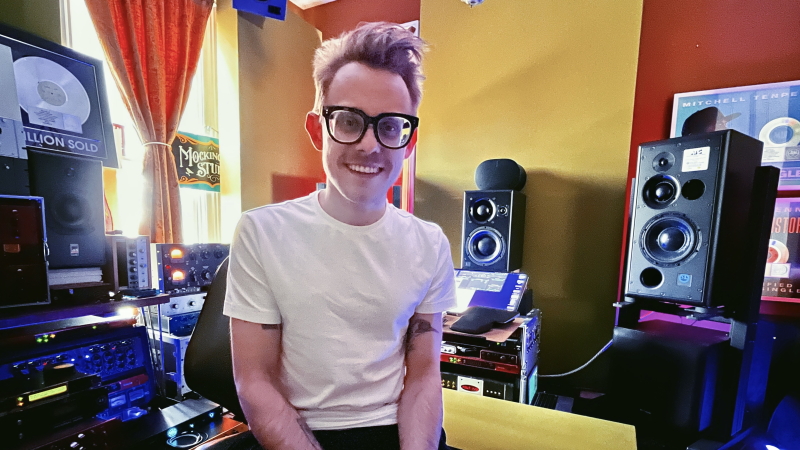Joseph Chudyk chooses Focusrite RedNet Components

When mix engineer and educator Joseph Chudyk first tried a Focusrite RedNet A16R Dante-networked 16x16 analog interface, he knew instantly that he was going to have to upgrade the setup at his private studio in Rochester, NY. “The moment I hooked the A16R up and heard the conversion out of the speakers, I was sold - the sound quality was much better than what I had been using previously,” he says.
Chudyk, who has mixed immersive versions of hits by the likes of Kane Brown, Mitchell Tenpenny, Elle King, and Miranda Lambert, and also teaches a recording class at Nazareth College in Rochester, had reconfigured his home-based mix room for immersive work not long after Apple Music announced the launch of its Spatial Audio platform, he says. But he had been battling some shortcomings in his converter system. After Focusrite Group Professional director Dave Rieley offered to send him a unit to evaluate, Chudyk made the switch, integrating three RedNet A16R units into his Dante-based studio setup to handle conversion between his DAW and outboard analog gear and to interface to his stereo and Dolby Atmos monitor systems.
“My whole studio is Dante-networked, so the ease of use of the A16R MkII over Dante helped as well, compared to my previous device,” says Chudyk, who mixes both stereo and immersive projects. “At that point I was starting to incorporate a little more analog hardware, so the ability to put the converter where the gear was, run a very short cable to the gear then just run one Ethernet cable to another Focusrite unit or directly into my computer was a big sell for me.” He has since also added a Focusrite PCIeNX card, supporting 128x128 channels, to his computer, he adds.
Reconfiguring his previous system would often require messing around with software or rebooting his computer, Chudyk reports. But with the Focusrite units, he says, “You plug them in, and the channel count just keeps going up. There’s no configuration necessary. It doesn’t matter which device is first or second. They’re very simple to use, and they’re reliable. They always work; never once have I had an issue with any of them. I can even unplug my computer, take into another room and plug it back in. All the units just reconnect without having to restart any application. I could not do that with any other piece of hardware.”
Chudyk’s outboard processing racks, which house a host of analog devices, including DW Fearn tube equalizers and a Fairchild 670 compressor, have become integral to his immersive mixing workflow. “EQ and compression are like panning for me,” he explains. “They give 3D movement. It’s the same with stereo mixing. If you want to pull something forward, back or higher or lower, you can do that with EQ, saturation and compression. So I’ve taken that same for approach to Atmos.”
On one recent spatial audio mix, he elaborates, “I switched in my two beautiful DW Fearn tube EQs and the vocal went from sounding far away in the room to being pulled forward without changing any panning position. Just the right color for a vocal can pull it forward. One panning move can totally screw the whole mix up for translation between platforms, but an EQ is going to keep the mix consistent. If I boost a certain frequency on the vocal it's going to do the same thing in Spatial Audio, Dolby or Tidal.”
Chudyk does still use panning to position elements: “I’ve found a template for where the vocals should be, panning-wise, that’s not too drastic and sounds great on all the platforms; same with the guitars and everything else. My panning is always set, and then I’ll play with a few little objects for movement if I need it. But where I really dive in, to move things forward and back, is with EQ and compression.”
Much of his focus with immersive mixing has been in the country music genre, thanks to connections through his manager in Nashville, Dane Schmidt, who handles his brother, producer and songwriter Jordan Schmidt and mixer, Jeff Braun. “Jeff does the stereo mix and I work on the Atmos; we have a great little team,” says Chudyk.
One of the first songs Chudyk mixed for immersive release was Kane Brown’s “One Mississippi,” which was RIAA-certified Platinum. “One of my favorite mixes I’ve ever done was Elle King and Miranda Lambert's ‘Drunk (And I Don't Want to Go Home).’ That just so happened to work really well in Atmos,” he says. “When you flip between the stereo and the Atmos, the Atmos almost sounds more open just due to the arrangement of the elements in the mix. I’m super proud of the mix, not even considering how popular that song was!” His extensive credit list also includes Teddy Swims, Ghost, IDK, Newsboys, MxPx, Nathaniel Rateliff, Joe Pug and The National Reserve.
Chudyk also uses his Focusrite RedNet converters together with monitor control software to manage his separate stereo immersive speaker systems. “I can switch between speakers and headphones. Then, in combination with that, I can switch between the stereo master reference, the 2.0 re-render, the Spatial Audio and the binaural. I can even have the Spatial Audio playback on speakers if I want to. I can hear the full range of what a mix will sound like and can make some different decisions based on that versus just using headphones.”
 How to resolve AdBlock issue?
How to resolve AdBlock issue?